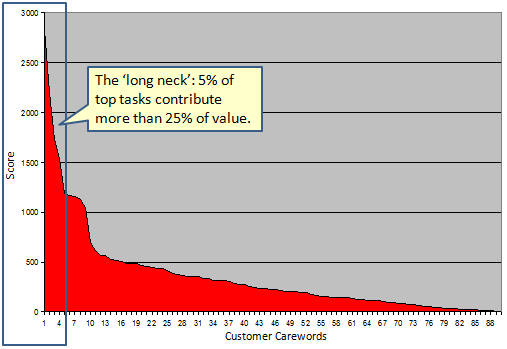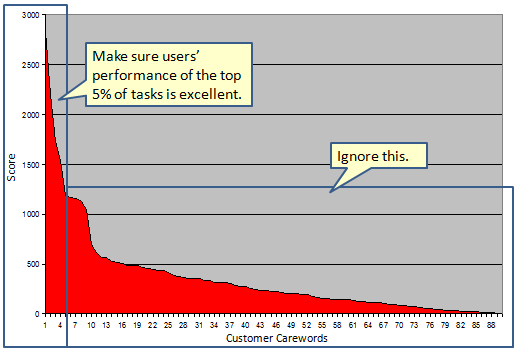Customer Carewords is a management process
The Customer Carewords process is more than a usability process; it’s a management process. Above and beyond producing hard evidence of users’ priorities and tasks, a Customer Carewords project generates focus and commitment from key stakeholders to a customer-centred website management strategy.
The process does that by generating real customer data, precise and statistical, from a unique voting process. Data that can be used over and over again to counter strong opinions and turf-wars in strategy and planning meetings (“The Minister wants his photo on the home page”, “The President thinks her welcome message should be prominent”, “We need to promote this product”, and so on). Data derived directly from customers; data not about their feelings and opinions, but about their top tasks.
Every website has a ‘long neck’ of top tasks
In all of the nearly 100 Customer Carewords projects that Neo Insight, Gerry McGovern, and our partners have undertaken, we always – always and without exception – find a ‘long neck’. And it doesn’t matter whether it’s a public website or an intranet, whether it’s a commercial, government or education website.
The ‘long neck’ is the very small set of ‘Top Tasks’ that visitors want and need to carry out quickly and successfully, time and time again. We find that around 5% of top tasks represent more than 25% of a site’s value to its users. The ‘long neck’ of Top Tasks is where the business case of a website is.
The chart below shows the results of one poll of intranet tasks, from an organization of more than 30,000. Over 2,000 employees voted on and prioritized their top tasks, from a list of over 100. As usual, an overwhelming number of the votes went to a small handful of tasks (For example, ‘Find a person’ is almost always the top task for an Intranet).

This is where the power of Customer Carewords data comes from. Real customer data, showing unequivocally not only what the top tasks are on any website, but just how important they are relative to all the other tasks. We often find that the top 5-10% of tasks gets around 35-45% of all votes and in a few instances they account for more than all the other tasks combined!
Focus on Top Tasks is the key to successful web management strategy
One of the key challenges to strategic thinking is a lack of focus – having too many initiatives, trying to please too many people, serving too many masters, failing to communicate a clear vision to staff, and so on. We see too many senior managers and organizations struggling with a lack of strategic focus for their public web presence and intranets. Managers cannot build strategic momentum if they lack evidence that will compel stakeholders. They need hard evidence of where to focus, as well as where not to focus. As Michael Porter points out:
“Strategy renders choices about what not to do
as
important as choices about what to do…
Some managers mistake ‘customer focus’ to mean they must
serve all customer needs or respond to every request…”
Customer Carewords data enable laser-sharp focus
Customer Carewords data enable a laser-sharp focus on the top tasks that deliver value to your users. It’s usually an amazingly small number of tasks. That’s just the kind of focus needed in order to allocate resources to the strategic value of a website.
This sharp focus will lead to:
- A more customer-focused website: Websites that are truly customer-centric; with web content that speaks the customers’ language, not the organization’s lingo.
- Management based on facts, not opinions: No more endless debates about what should and shouldn’t be on your website or home page, or in the navigation links. Hard, defensible, compelling data that shows exactly what your customers want – and don’t want.
- A simpler website: Strip away all the filler content from your website. Create a clean, lean website that focuses on exactly what your customers care most about.
Your website management strategy in one slide
So, what’s that strategy, what’s that chart we talked about earlier? Here it is:

Simple, huh? Just two elements:
1. Make sure your users’ performance on the top 5% of tasks is excellent
You need to get your team focused around ensuring customers achieve ‘excellent’ performance on Top Tasks. You first need to discover and measure how well customers are able to perform now. Then set tough but achievable targets to improve performance to ‘excellent’, including:
- Get Top Task completion by target users as close to 100% as possible
- Get task time on Top Tasks close to the optimal time
- Get ‘disaster’ rates on top tasks close to 0%
See definitions of these task metrics on the Customer Carewords website
2. Ignore this
OK, this may be a bit radical and – intentionally – provocative. But, if you want those big wins, and to pull your web strategy out of the mire that we see in so many organizations, you may need a short-term plan as radical as this. Maybe this is the kind of chart to jolt your management team awake at the next strategy meeting.
We see so many organizations with large websites struggling with strategy. After 15 years of ‘cheap’ publishing to the web, their strategy has become overwhelmed. Unless you have a very clear business model that incorporates the 95% of lower-priority user tasks, the risks in trying to deal with them are:
- The issues will get too complex
- Too many people will need to be involved
- The politics will become more problematic
- It will take significant effort away from the top 5% (even just quantifying the problems will require significant resources!)
- There still won’t be enough resources allocated to do a good job
- Management decisions will get harder to make
- It will be more difficult to show real progress that delivers business value
We’re essentially saying that, for many organizations, the most effective web strategy is to focus only on users’ Top Tasks. Once those are working well you can move on to the next priority tasks. We’re saying ‘Ignore the 95% for now’, and ‘Ignore the 95% except as they affect performance on the Top Tasks‘.
But we can’t ignore those other tasks!
In truth, it’s impossible to ignore the 95% of lower-priority user tasks completely, so in part 2 of this article we shall refine this web strategy – but still on one chart!
Related articles and references
- More about the ‘long neck’, with examples & more charts
- Web management strategy: Don’t boil the ocean
- Managing websites is about managing, not about websites
- Michael Porter quotes are from: “What is Strategy?” in The Strategy Reader, Susan Segal-Horn (Ed.) Wiley-Blackwell; 2 edition, 2004.
Read part 2 of ‘Your website management strategy in 1 chart’
What do you think are the most important factors in Search design? Help us collect data by completing Gerry McGovern’s latest survey—and you can sign up to see the results.
Search design factors: online survey
Top Neo Tweets
Tweets fly by so fast! In case you missed them, here are some of our recent ones…
- Hey! Another advantage of remote usability testing: Reduce spread of H1N1!
- RT @gerrymcgovern Surviving information-seeking sickness: http://bit.ly/sxuTv
- RT @gerrymcgovern The ‘search, compare, verify’ generation: http://bit.ly/2XyRYP
- U.S. Govt. guidelines for focusing on Top Tasks: http://bit.ly/At3Bo
- All(?) Canadian Govt Public Opinion Research reports online. Some UX/sat/usability. No search/facets; poorly organized: http://bit.ly/Affga
- Google Chrome staffers ask New Yorkers: only 8% know what a browser is. Moral: Even basic techno-speak is techno-speak. http://bit.ly/13BUVL
Quote of the month
“People think focus means saying yes to the thing you’ve got to focus on. But that’s not what it means at all. It means saying no to the hundred other good ideas that there are. You have to pick carefully. I’m actually as proud of many of the things we haven’t done as the things we have done.”
Steve Jobs


